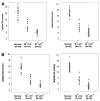Tissue Doppler imaging consistently detects myocardial abnormalities in patients with hypertrophic cardiomyopathy and provides a novel means for an early diagnosis before and independently of hypertrophy
- PMID: 11447072
- PMCID: PMC2900859
- DOI: 10.1161/01.cir.104.2.128
Tissue Doppler imaging consistently detects myocardial abnormalities in patients with hypertrophic cardiomyopathy and provides a novel means for an early diagnosis before and independently of hypertrophy
Abstract
Background: Left ventricular hypertrophy (LVH), the clinical hallmark of familial hypertrophic cardiomyopathy (FHCM), is absent in a significant number of subjects with causal mutations. In transgenic rabbits that fully recapitulate the FHCM phenotype, reduced myocardial tissue Doppler (TD) velocities accurately identified the mutant rabbits, even in the absence of LVH. We tested whether humans with FHCM also consistently showed reduced myocardial TD velocities, irrespective of LVH.
Methods and results: We performed 2D and Doppler echocardiography and TD imaging in 30 subjects with FHCM, 13 subjects who were positive for various mutations but did not have LVH, and 30 age- and sex-matched controls (all adults; 77% women). LV wall thickness and mass were significantly greater in FHCM subjects (P<0.01 versus those without LVH and controls). There were no significant differences in 2D echocardiographic, mitral, and pulmonary venous flow indices between mutation-positives without LVH and controls. In contrast, systolic and early diastolic TD velocities were significantly lower in both mutation-positives without LVH and in FHCM patients than in controls (P<0.001). Reduced TD velocities had a sensitivity of 100% and a specificity of 93% for identifying mutation-positives without LVH.
Conclusions: Myocardial contraction and relaxation velocities, detected by TD imaging, are reduced in FHCM, including in those without LVH. Before and independently of LVH, TD imaging is an accurate and sensitive method for identifying subjects who are positive for FHCM mutations.
Figures
Comment in
-
Hypertrophic cardiomyopathy: from bedside to bench...and now back again?Circulation. 2001 Jul 10;104(2):126-7. doi: 10.1161/01.cir.104.2.126. Circulation. 2001. PMID: 11447071 No abstract available.
Similar articles
-
Tissue Doppler imaging consistently detects myocardial contraction and relaxation abnormalities, irrespective of cardiac hypertrophy, in a transgenic rabbit model of human hypertrophic cardiomyopathy.Circulation. 2000 Sep 19;102(12):1346-50. doi: 10.1161/01.cir.102.12.1346. Circulation. 2000. PMID: 10993850 Free PMC article.
-
Diastolic abnormalities as the first feature of hypertrophic cardiomyopathy in Dutch myosin-binding protein C founder mutations.JACC Cardiovasc Imaging. 2009 Jan;2(1):58-64. doi: 10.1016/j.jcmg.2008.08.003. JACC Cardiovasc Imaging. 2009. PMID: 19356534
-
Early detection of Fabry cardiomyopathy by tissue Doppler imaging.Circulation. 2003 Apr 22;107(15):1978-84. doi: 10.1161/01.CIR.0000061952.27445.A0. Epub 2003 Mar 31. Circulation. 2003. PMID: 12668521 Clinical Trial.
-
Hypertrophic cardiomyopathy: preclinical and early phenotype.J Cardiovasc Transl Res. 2009 Dec;2(4):462-70. doi: 10.1007/s12265-009-9124-7. Epub 2009 Sep 26. J Cardiovasc Transl Res. 2009. PMID: 20560004 Review.
-
Clinical aspects of left ventricular diastolic function assessed by Doppler echocardiography following acute myocardial infarction.Dan Med Bull. 2001 Nov;48(4):199-210. Dan Med Bull. 2001. PMID: 11767125 Review.
Cited by
-
Left ventricular regional systolic function in patient with hypertrophic cardiomyopathy by quantitative tissue velocity imaging.J Huazhong Univ Sci Technolog Med Sci. 2006;26(1):153-6. doi: 10.1007/BF02828065. J Huazhong Univ Sci Technolog Med Sci. 2006. PMID: 16711033
-
The role of cardiac magnetic resonance imaging in differentiating the underlying causes of left ventricular hypertrophy.Neth Heart J. 2010 Mar;18(3):135-43. doi: 10.1007/BF03091752. Neth Heart J. 2010. PMID: 20390064 Free PMC article.
-
Genome-wide mapping of modifier chromosomal loci for human hypertrophic cardiomyopathy.Hum Mol Genet. 2007 Oct 15;16(20):2463-71. doi: 10.1093/hmg/ddm202. Epub 2007 Jul 25. Hum Mol Genet. 2007. PMID: 17652099 Free PMC article.
-
Can an energy-deficient heart grow bigger and stronger?J Am Coll Cardiol. 2003 May 21;41(10):1783-5. doi: 10.1016/s0735-1097(02)03008-5. J Am Coll Cardiol. 2003. PMID: 12767665 Free PMC article. No abstract available.
-
Tissue Doppler, strain, and strain rate echocardiography for the assessment of left and right systolic ventricular function.Heart. 2003 Nov;89 Suppl 3(Suppl 3):iii9-17. doi: 10.1136/heart.89.suppl_3.iii9. Heart. 2003. PMID: 14594870 Free PMC article.
References
-
- Maron BJ, Shirani J, Poliac LC, et al. Sudden death in young competitive athletes. Clinical, demographic, and pathological profiles. JAMA. 1996;276:199–204. - PubMed
-
- Niimura H, Bachinski LL, Sangwatanaroj S, et al. Mutations in the gene for cardiac myosin-binding protein C and late-onset familial hypertrophic cardiomyopathy. N Engl J Med. 1998;338:1248–1257. - PubMed
Publication types
MeSH terms
Grants and funding
LinkOut - more resources
Full Text Sources


